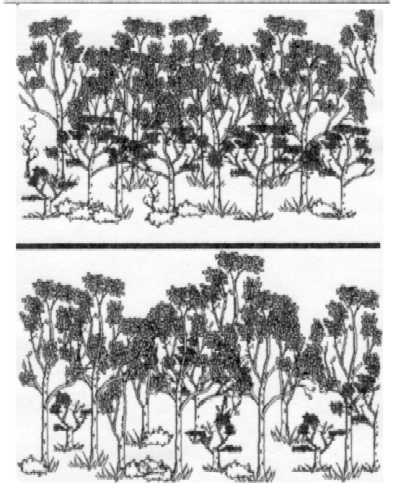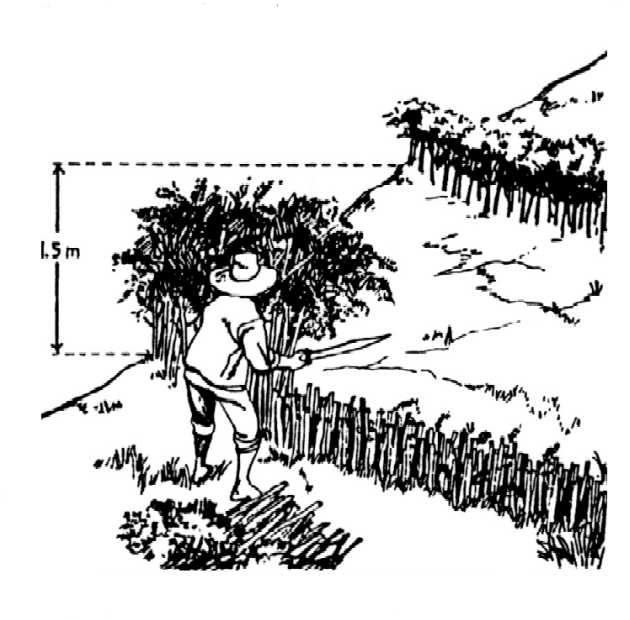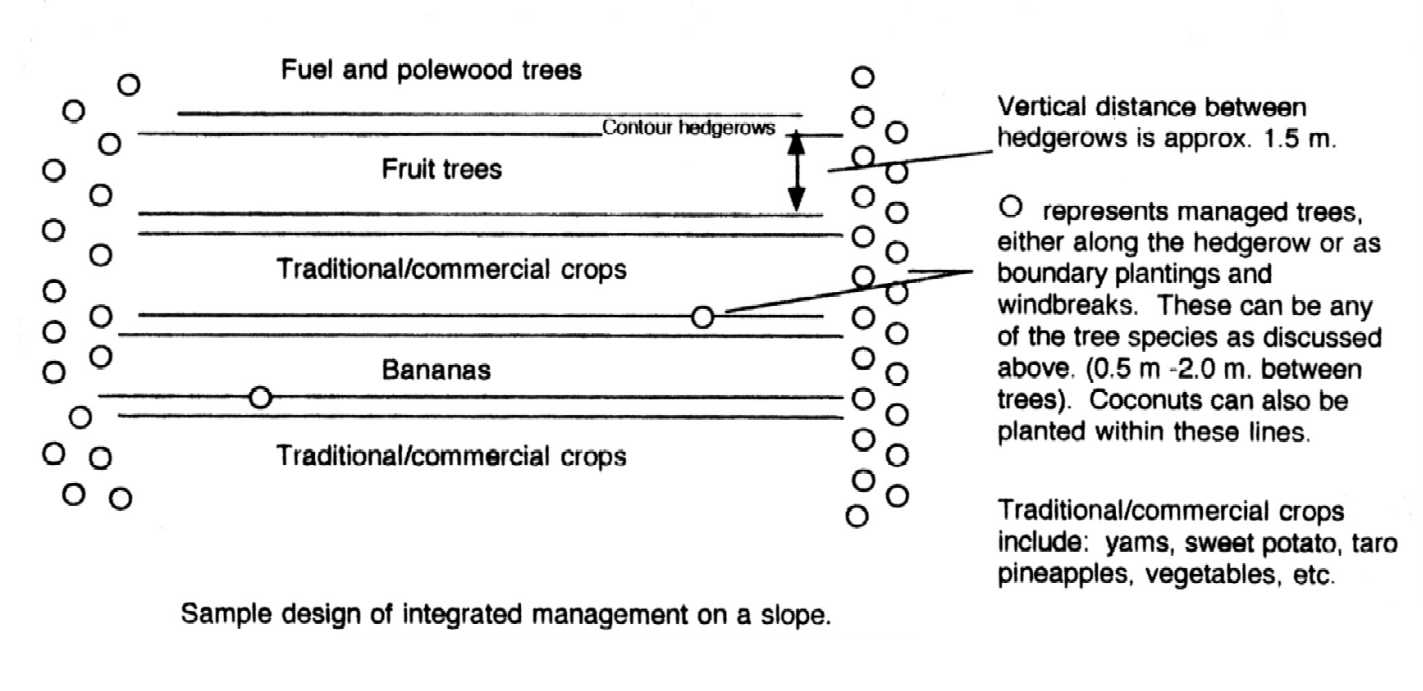
Fuelwood production in the South Pacific
Agroforestry for the Pacific Technologies
A publication of the Agroforestry Information Service
December 1994, Number 9
Trees and forests are an important part of island resources. Trees can help the environment and provide the opportunity for future development activities. The importance of trees and forests is well known to Pacific Islanders. Traditionally valued as a source of building materials for homes and canoes, food, firewood, fiber, medicine, and flowers, the significant role of trees is often taken for granted. Population growth, commercial and private development, and indiscriminate gathering of firewood and wood products are degrading the islands’ native forest resources. In order to stop and reverse environmental problems due to the loss of native forest, a combination of traditional land management practices and innovative planning strategies is required. A basic element in achieving this goal is planting trees.
 Fuelwood situation
Fuelwood situation
In the South Pacific Islands the import of energy resources accounts for a substantial portion of the economy for many island nations and territories, with most commercial and domestic energy being provided by petroleum fueled generators. Despite the increased reliance on these nonrenewable energy sources for modern societal needs, the continued use of wood fuel retains significant importance for traditional uses. This continuing importance suggests the need to promote both the public and private production of fuelwood to relieve pressure on native forest resources. Trees and shrubs contribute to energy supplies throughout the islands, while providing many other products and services as well.
The concept of incorporating trees in land use management is not new to the islands. Throughout the history of island settlement, the principal source of fuelwood has been attributed to the clearance of forest land for agricultural production. Traditional management schemes were also dependent upon trees as providers of nutrients, shade, and pest management. But, with escalating urbanization and population pressures, as well as interest for maximizing agronomic crop yields increases, the renewability of the forest resources in the South Pacific Islands is quickly being compromised. The role of trees becomes secondary.
Tropical storms
Throughout the South Pacific region the importance of natural disturbances in the form of tropical storms and hurricanes must be a prime consideration for the design and implementation of new resource management practices. These disturbances have always been a part of island life and regional development.
Most of the island nations and territories of the Pacific lie within the area of cyclogenesis and the subsequent path of storm tracks, being frequently affected by these annual disturbances. the season normally extends from December to April, with an average of 15 storms or cyclones of hurricane strength in any given year. Proper species selection that minimizes the risk of loss due to storm damage will promote opportunities for private production of fuelwood in small woodlots or as a component in an integrated land use system. Some tree species are better suited to perform these roles than others.
The greatest damage usually occurs at the forest edge, where the transition of vegetative type is most abrupt due to forest clearance for agriculture and urban development. Lessening the abruptness of this edge and maintenance of the vegetative structure across the landscape could result in decreased damage to crops and property located in the cleared areas. Due to the frequency of these storms, the importance of wind-firmness and the ability to recover following a storm are essential to management and design of land use strategies which incorporate tree crops. Although most species suffer some degree of damage, differences in resilience and recovery may suggest favorable usage.
Species Selection
While trees can provide many benefits, they can decrease the short-term productivity of an area. Proper selection and management of the right species is important, and can enhance crop yields while providing additional products which will help compensate for any lose. Resulting micro-environmental changes may even allow production of other crops. Some criteria for selection include:
- multiple uses
- fast growth
- adaptability to the local environmental conditions
- compatibility with other plants
- tolerance to minor injuries
- availability of planting stock
- market potential
Good growth and survival, both during normal years and following a tropical storm, should be used to decide which trees to plant in your fields and around your home. All of the species presented below provide a variety of products, and are fast growing, wind-firm, compatible with traditional crops, and available throughout the Pacific region:
Acacia auriculiformis *
Adenanthera pavonina
Albizia chinensis
Alphitonia zizyphoides
Calliandra calothyrsus
Casuarina equiselifolia
Eucalyptus camaldulensis
Eucalyptus urophylla
Gliricidia sepium *
Securinega flexuosa
* Information available from the Nitrogen Fixing Tree Association (NFTA)
There are many other common trees, as well as coconut, breadfruit, and other fruit trees that can be planted on farms. Planting and management of different combinations of trees can provide a number of products and help to limit damage in case of a tropical storm. Below are some suggestions concerning ways to plant these trees around crop fields and homes.
Line Plantings
Planting trees 1.0 m to 2.0 m apart in a line along field or property boundaries can protect crops from wind damage. This initially thick planting can be thinned by harvesting every other tree after 3 to 5 years, providing firewood and construction materials while maintaining the function of the windbreak. Adenanthera pavonina, Albizia chinensis, and Acacia auriculiformis all have similar shapes and growth characteristics, and can be used in line plantings. All three species resprout following harvest or wind damage, providing an excellent source of quality firewood. These trees can be planted together, either in a single line or by combining a number of lines. They can also be planted within crop fields in lines or as individuals. The small leaflets provide light shading and make good mulch, helping to control weeds and conserve soil moisture. Albizia chinensis and Acacia auriculiformis are nitrogen fixers. When planting within crop fields, trees should be at least 0.5 m to 1.0 m tall. This will help prevent damage to the trees during crop planting and maintenance.
Eucalyptus spp. and Securinega flexuosa can also be planted in combination with Adenanthera, Albizia, and Acacia. These two trees have a tall, narrow shape and will grow well between the more branchy, rounded shape of these other trees. Eucalyptus and Securinega provide a good source of small poles and/or fuelwood in only 3 to 5 years. If land is available, small block plantings can provide marketable pole products in a relatively short time. Otherwise, line plantings of these trees are good along roadsides and property boundaries.
Casuarina equisetifolia is very windfirm and can protect both crops and property from wind and salt spray damage. While this tree grows well along the coast, it can also be planted inland. Planting a line at close spacing will provide a strong barrier to wind. Spacing between trees can vary from 0.5 m to 1.5 in for this purpose. Some trees can be harvested later for firewood or other wood products. Multiple-line plantings of Casuarina are best, with the trees being offset between lines, so as not to funnel the wind through any gaps or holes. Casuarina is best planted around field borders and property boundaries. Securinega and Eucalyptus can be planted with Casuarina on inland sites.
Although the optimum orientation of boundary/line planting which serves as a windbreak is perpendicular to the prevailing winds, tropical storms often are accompanied by shifting wind patterns. Making use of a grid design, a technique of planting lines of trees in a crisscross pattern forming several small squares within or around crop fields, can provide protection against shifting winds.
Alphitonia zizyphoides, like many other native forest trees, is an excellent source of firewood and construction timber. This large tree is best planted and managed on old field sites, surrounding crop fields, or near the home.
 Contour Hedgerows
Contour Hedgerows
Planting woody hedgerows along the contour of sloping land combines the advantages of soil conservation and multiple product yields. This integration of food and forest species serves to control soil erosion, help restore soil fertility and structure, and efficiently produce a variety of products. Contour lines are easily established with the aid of an A-frame. These lines can be from 1.5 m to 5.0 m apart depending upon the steepness of the slope. The area between these lines is planted with annual agricultural and perennial fruit crops.
Hibiscus manihot is a useful shrub for the early stages of contour hedgerow establishment. Cuttings of this shrub are easily planted, and grow quickly. This species can then be followed by the sowing of seeds, planting of cuttings, or seedlings grown in the nursery. This will help to maintain and strengthen the hedgerow.
Seeds of Calliandra calothyrsus and cuttings of Gliricidia sepium work well for this purpose. These two trees can be pruned every 3 to 4 months to maintain a short height. The vigorous resprouting ability of these trees makes for a thick hedgerow and provides a large quantity of mulch. When the hedgerow is 1.5 m to 2.0 m tall, it can be cut back to 0.5 m, with the cuttings being placed both behind the hedgerow to build up a terrace, or placed among the crops as mulch. Both species are nitrogen fixing.
One tree can be left uncut every 5.0 m along the hedgerow to provide for other product needs like fuelwood. Any of the other trees discussed here can also be planted at 5.0 m to 10.0 m spacing along the hedgerow. Multiple lines of trees and nitrogen-fixing shrubs and grasses will provide diversity and added stability to the hedgerow.

Calliandra, Gliricidia and Leucaena can also be planted and managed as trees around piggeries and along field borders. They provide a quick source of firewood and light construction wood for agricultural needs (planting sticks, banana props, fence posts, etc.). They also provide shade and bedding materials for the animals.
Utilization of trees in multiple- and single-line plantings, and in contour hedgerows promotes the use of multipurpose tree species that can benefit present management strategies and reduce the impact on the native forest resources.
Zonation of crops incorporating sloping agricultural land technology (SALT) would provide additional advantages. The incorporation of trees within a land holding as part of the overall management plan is necessary, not just in agricultural plots, but in the context of the entire production system.
While native species deserve foremost consideration, and should be emphasized, the use of exotics must also be acknowledged as a potential solution to the increasing problems of resource degradation. Consideration of seed and planting material availability and concerns of invasiveness must also figure in the evaluation and selection process.
The extensive use of fuelwood for both traditional and daily food preparation will remain important throughout the South Pacific despite the availability of alternative fuel and energy sources. Through a combination of culture, tradition, and technology, trees can be used to provide for these needs, helping to benefit farm production and protect island environments.
Written by Richard van-C. Adkins, P.O. Box 1433, Safford, AZ 85548-1433 USA. Information included in this Fact Sheet resulted from a Master’s thesis submitted at Utah State University. The research is based on the author’s work with the
American Samoa Community College Land Grant Program and the Institute of Pacific Islands Forestry, USDA Forest Service, Honolulu, Hawaii. The species trials are located on the island of Tuuila, American Samoa.
A publication of the Forest, Farm, and Community Tree Network (FACT Net)
Winrock International
Email: forestry@msmail.winrock.org
